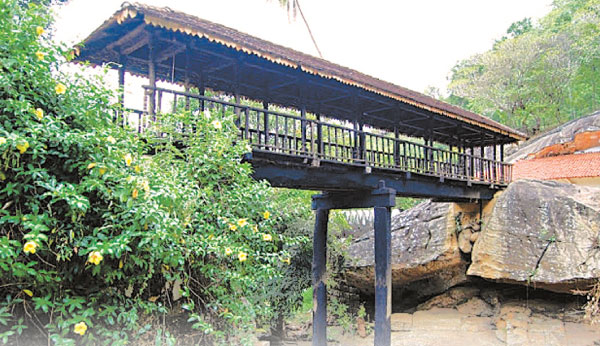|
Beautiful spaces in Sri Lanka:
Bogoda bridge at Bogoda Raja Maha Vihara
by Husna Inayathullah
 Bogoda
Raja Maha Vihara is famous for its wooden bridge of the Kandyan era. It
is the oldest wooden bridge in the world. It is in Hali-Ela in Badulla.
The bridge was built across the Gallanda Oya which is a branch of the
Uma Oya. It is completely made of wood without a single metal nail being
used. Bogoda
Raja Maha Vihara is famous for its wooden bridge of the Kandyan era. It
is the oldest wooden bridge in the world. It is in Hali-Ela in Badulla.
The bridge was built across the Gallanda Oya which is a branch of the
Uma Oya. It is completely made of wood without a single metal nail being
used.
The bridge is 50 feet long and five feet wide. It has a roof to
protect the bridge and the people who walk on it. The pillars are
beautifully carved with ancient designs. In the past it has been used as
a bridge to cross the stream and also as an Ambalama.
There is an old temple near the bridge. There is also a cave which
the Bhikkhus had lived in during ancient times. People still use this
bridge which is in good condition.
Bogoda with its ancient temple and wooden bridge lies some 30
kilometres from Bandarawela and 10 km from Badulla. It is off the
Hali-ela junction.
The Bogoda bridge dates back to the 1600s but the temple itself has a
much longer history and dates back to the 1st century BCE.The bridge is
still the road link used by many villagers around.
The first bridge was probably a few logs thrown across the stream
according to chronicles.
The base consists of a single standing log,a huge Kumbuk tree 35 feet
in height.

Three huge jak trunks is flung across the stream to form the platform
on which during the Kandyan era the elaborate wooden structure came into
being. The roof has distinctly Kandyan style tiles and even the modest
decor on the wooden pillars holding up the roof is reminiscent of that
era.
 A
stone inscription by the temple in Brahmin scripture says the
drip-ledged cave behind the temple was donated to a priest called
Brahmadatta by Tissa, a provincial leader in Badulla. A
stone inscription by the temple in Brahmin scripture says the
drip-ledged cave behind the temple was donated to a priest called
Brahmadatta by Tissa, a provincial leader in Badulla.
King Valagamba in exile from Indian invaders had sought refuge here
for two and a half years. Behind the temple by the drip-ledged cave is
the entrance to a tunnel. It is very dark, bat-infested and wet that one
cannot really venture in more than a few metres.
The tunnel ends in a near-by estate called Tudumale. From that end
one can travel about500 metres into the cave. According to history the
tunnel measures 12 miles and ends at Naranwala which is now the estate.
On King Valagamba's instructions a temple was built incorporating the
cave and several statues which were already there in the cave.
Built with the King's patronage, it soon became known as the Bogoda
Raja Maha Vihara.
The Vishnu Devale had existed before the temple was constructed. The
standing statue of a blue God Vishnu is now partially covered by a wall
built separating the cave into two chambers.

A large statue of the reclining Buddha in Samadhi posture with an
elaborate Makara Thorana (a dragon-like mythical creature combining
features of elephant, bear, lion and crocodile)over it and a standing
Buddha are also old statues dating even before the Vihara.
This Makara Thorana is an unusual structure. It shows the Makara in a
different posture from the conventional one in other ancient temples.
This is the only temple where the mouth and trunk of the dragon is
not depicted sideways but facing and directly above the statue. It is
our duty to protect and appreciate these types of magnificent creations. |

